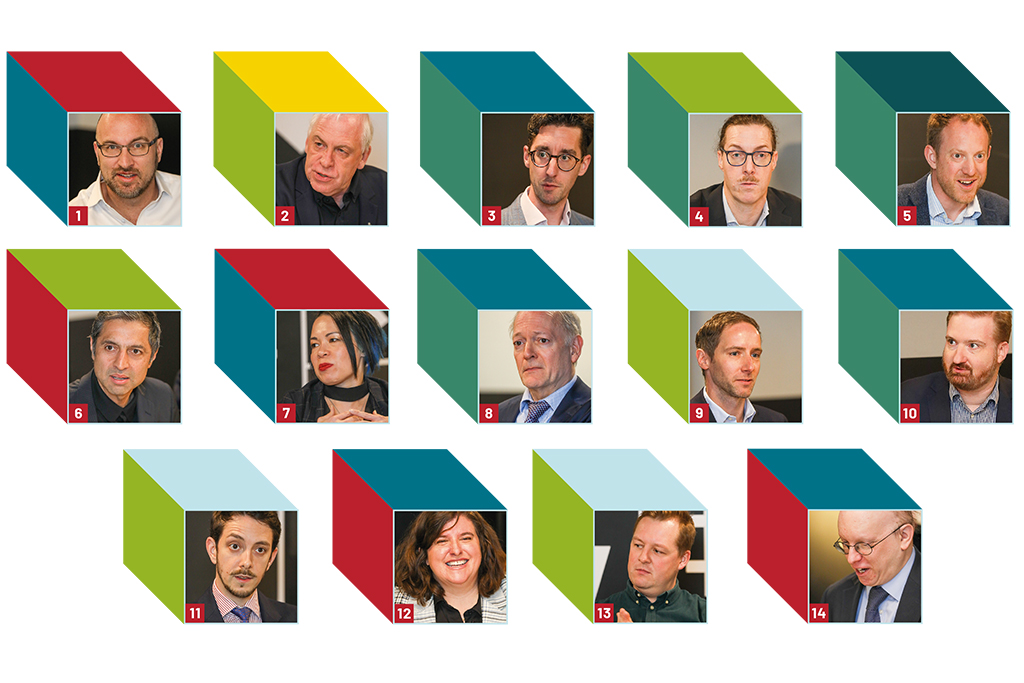There are many reasons why the industry needs to improve its data gathering and sharing. Construction News and Quickbase brought together key members of the industry to explore the issues involved
On the panel
1 Daniel Cook, chief executive, Active Building Centre
2 Peter Sutcliffe, head of technical practice - building engineering, Aecom
3 Phil Brown, director, Arcadis
4 Andrea Gillarduzzi, senior technical director, Arcadis
5 Simeon Seamer, head of construction, UK & Ireland, Berkshire Hathaway Specialty Insurance
6 Harbinder Birdi, creative director, Birdi
7 May Winfield, global director of commercial, legal and digital risks, Buro Happold
8 Lee Brankley, chief executive, Cares
9 Kevin Masters, technical director, KPMG
10 Robert Fawn, head of integrated management systems, Tilbury Douglas Construction
11 Edward Jezeph, senior investment manager, Homes England
12 Caroline Stuart-Freas, senior customer success manager, Quickbase
13 Andy Winter, account executive, Quickbase
14 Chair: Construction News deputy editor Ben Vogel
Roundtable sponsor: Quickbase
The lack of data on construction that is stored, maintained and shared has “huge costs” for public efforts to improve the standards of residential buildings, according to a senior investment manager at the government’s housing accelerator. Homes England’s Edward Jezeph says that while there is a wealth of digital information about buildings at their early stages, once they are completed this “vanishes”, affecting efforts to tackle issues such as embodied carbon and energy efficiency.
This is just one of the problems with data fragmentation in the sector shared at a roundtable held in central London by Construction News, sponsored by dynamic construction management software provider Quickbase. Project costs, the requirements of the Building Safety Act, and insurance are among the other big drivers of better data collection.
Huge challenge
“We’ve got 24 million homes in England and deliver about 240,000 a year,” Jezeph says. “We have a lot of digital information about those buildings as they’re designed in our planning database and in construction, but then it vanishes.
“As soon as that home is completed, the information is no longer available, so if I want to work out how that home was built I’ve got to send a surveyor in.”
This causes a “huge challenge” for complying with certain policies, including getting buildings to operate with net-zero carbon emissions, he explains. “I need the existing data used in the construction process to live on and be accessible, then I can use that for the purposes of the retrofit agenda, including the £10,000-£40,000 we’re going to have to spend on every single house to get it up to standard – or to make the business decision that it’s no longer economically worth continuing with and replace it.”
Others make similar points. Daniel Cook, outgoing chief executive of research and advice body the Active Building Centre, agrees that not enough data is available as standard. He says the organisation worked with housebuilder Greencore Construction to examine whether its homes are climate-positive – meaning that they save more greenhouse gas emissions than generated during their build. “They use materials and choices that reduce the embodied carbon and maximise energy production over the lifetime of their buildings,” he says. “I think they are a leading light in the industry and they collected all of that information in the BIM model to enable those calculations to be undertaken.
“But there is a lack of standards and requirements in that market. If you look at somewhere like the US, it is much more mandated.”
Is it just a lack of regulations that causes project data to be lacking, or is there more to it? For Lee Brankley, chief executive of steel certification body Cares, a fragmented industry causes data fragmentation, with the multitude of parties involved in projects – clients, contractors, subcontractors and different product manufacturers – at the root. “I think the challenge is that all the different parties in the value chain have different computer systems, are collecting different data in different formats and sharing that data in different ways. The challenge is to connect the data across the different parties involved,” he says.
Many believe that these hurdles can be overcome, though.

Client clarity
“A lot of data fragmentation starts because people don’t say what they want at the beginning,” says Buro Happold global director of commercial, legal and digital risks May Winfield. “If you are very clear: ‘I want this,’ and the other person says: ‘This is what I’m going to provide and this is how I’m going to do it,’ you probably have very little data fragmentation because the expectations are very clear.”
Having that clarity from clients is helpful, agrees Robert Fawn, head of integrated management systems at Tilbury Douglas. “It’s normally a good developer identifying early doors what they need and working with key quantity surveyors, architects and other stakeholders, and then everything else comes downstream. Then it needs all the other parties involved to contribute and get onboard, as required.”
As well as the net-zero agenda, the Building Safety Act requirement for those involved in the construction process to be able to demonstrate features of their work to the Building Safety Regulator also generates a pressing need for good data collection, the panel hears.
KPMG technical director Kevin Masters says project finance is also increasingly linked to demonstrations of carbon credentials and safety. “A large capital project won’t get funding at a decent rate unless it can demonstrate all the way through the supply chain that people are doing what they say they’re doing. The industry having to respond to that question of trust [is part of] the Building Safety Act question.
“I think [the industry] has been struggling with a lack of trust and this is now an opportunity for us to collectively address that and start to build trust with our patrons and with our customers.”
Simeon Seamer, head of construction, UK & Ireland, at Berkshire Hathaway Specialty Insurance adds that his industry is looking for contractors to be able to share consistent data over time.
Barriers
Better sharing of data could also have many benefits within the industry, including improving the delivery of national infrastructure, several participants say.
But there are barriers to sharing the information, not least an individual company’s intellectual property. Arcadis director Phil Brown says: “We need to figure out what data is sacrosanct, what data do we actively need in infrastructure that enables other data sets to come alive? Then we [need to] define what is in the public and social good versus what [is needed] to innovate. I think that would breed positive competition.”
Birdi creative director Harbinder Birdi, meanwhile, calls for regional mayors and local authorities to facilitate the sharing of project data. He points out that the number of in-house architects has fallen sharply at councils in recent years.
“Are local authorities writing briefs where they understand what data they want, and have they got people in their boroughs that actually know how to open it and use it?” he asks.
Usability
That ability to use data becomes a major point of the discussion.
Peter Sutcliffe, head of technical practice – building engineering at Aecom, says: “There are
lots of very clever people developing digital tools. The industry is starting to link some of those together but there’s still a long way to go. The big issue is getting it down through the business, otherwise you end up with almost a two or three speed operation where [use of the tools] is the preserve of the top 5 per cent but people on the coalface struggle to understand where we’re going.”
Arcadis technical director Andrea Gillarduzzi echoes the sentiment. He says digital tools need to be carefully selected on criteria including functionality, usability, reliability and cost.
“I’ve been involved in the selection of software and I found that one of the biggest problems is a lot of times it’s selected almost out of emotion, without thinking about it,” he says.
Andy Winter, from software provider Quickbase, also says making tools usable is key to their effectiveness, despite challenges posed by construction inflation.
“Project and material costs can change so quickly, so by the time a business pulls together and downloads all the information, pulls it into a report and sends it, the cost might not be accurate [any longer],” he says.
“You need tools that allow for continuity and to put software in people’s hands that is easy to use, and which they see as saving them time. Someone who has been doing the same job for 30 years needs to see it as routine.”
 Construction News Read UK Construction Industry News, Analysis, Opinion and data
Construction News Read UK Construction Industry News, Analysis, Opinion and data 